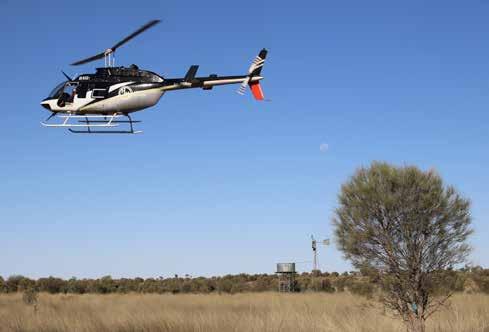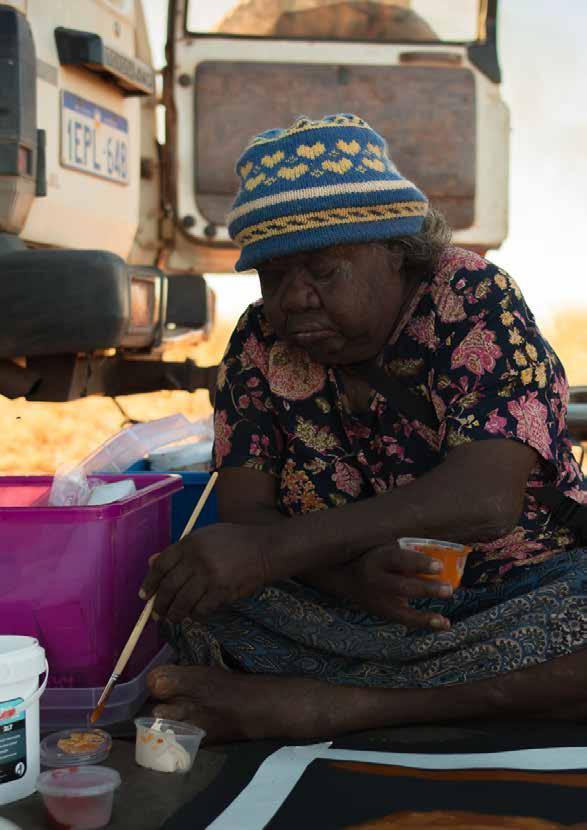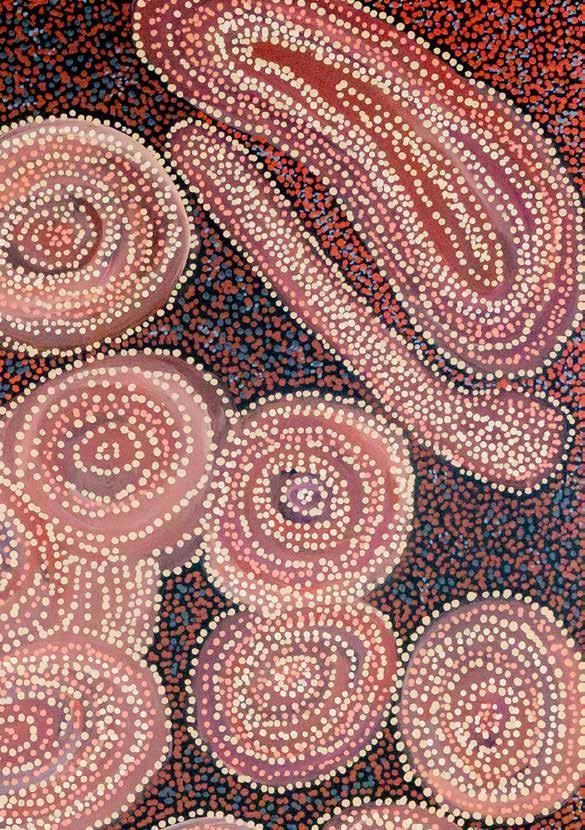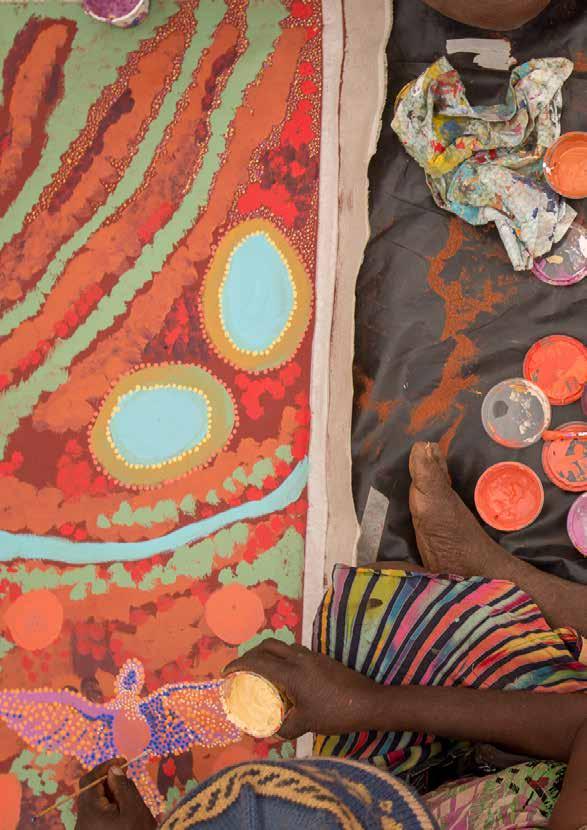Luurn, the Kingfisher
Agency acknowledges the Traditional Owners and Sovereign Custodians of the land on which we live and work. We extend our respects to their Ancestors and all First Nations peoples and Elders past, present, and future.
Agency, in partnership with Warlayirti Artists is pleased to present, Luurn, the Kingfisher - a solo show by Kukatja artist, Miriam Baadjo.
Saturday 21 June – Saturday 26 July, 2025
Wukun Wanambi Project Space, Agency Projects
Agency is an Aboriginal and Torres Strait Islander non-for-profit that celebrates and promotes First Nations art, culture and people on a local, national and international scale.
Agency
47 Easey Street, Collingwood
Wednesday - Saturday, 12 - 5pm
Miriam Baadjo on Country. Image courtesy of Warlayirti Artists.
Miriam Baadjo
Miriam Baadjo’s family lineage runs deep into the Great Sandy Desert. The story of how her family came to the mission at Balgo is as epic and layered as the Tjukurrpa stories she now paints on canvas.
As the family tells it, a giant dragonfly once swallowed a young boy—offering him a chance at life saving treatment. His people travelled north, away from their Country, to seek help from the white missionaries. That boy would become known by the legendary name Helicopter (Joey Tjungurrayi). Among those who followed him were Miriam’s mother, Biddee Baadjo (c.1935–2022), and her older sister Tossie, then just a child. They journeyed to the Old Balgo Mission, where most of the family would settle.
At the mission, they laboured: tending animals, baking bread, and building a new life on the edge of their ancestral lands. Tossie was taken into the dormitory system, and years later, baby Miriam joined her—both raised Catholic under the care of the nuns.
Miriam comes from a family of art pioneers — her uncle Wimmitji Tjapangarti, Lucy Yukenbarri, Patrick Olodoodi, Brandy Tjungurrayi, and Josephine Nangala are all major figures in the Western Desert painting movement. Biddee herself would later paint for Wangkatjungka Artists, inspired by her Balgo-based relatives. It was Wimmitji who passed down stories of places like Nyila and the Luurnpa (kingfisher), shaping Miriam’s creative path.
As a next-generation Balgo artist, Miriam has lived between two worlds—disconnected from Country, yet spiritually bound to it. Art became a means of reconnection, a tool for healing and storytelling.
Though she began her creative career working with glass and screen printing, it was her brother-in laws Brandy and Patrick who encouraged her to pick up the brush. Her talent was undeniable: a deft hand, bold colour mixing, and the rare ability to draw freely with precision and instinct. Her works are distinctive—rich with memory, cultural narrative and a vibrant sense of place.
With permission to paint her uncle Wimmitji’s Tjukurrpa, Miriam shares:
“He was telling me to paint my father’s Country. It made me feel strong.”
Miriam is an artist in the truest sense. Her works have been exhibited nationally and internationally, held in public and private collections, and selected for major art prizes. Her paintings have inspired operas, and her creativity has taken her across the globe—from painting an Audi in Japan to completing a mural in Mumbai.
But her most profound journey has been the one back to Country.
Through the Ngurra Kutjuwarra (On Country, Together) program, Warlayirti Artists has led expeditions to places like Nyinmi Outstation (west of Kiwirrkurra), and by helicopter to sacred sites including Nyila and Winpurpurla—places long out of reach, not visited since that dragonfly took the boy away.
“There are too many sandhills in the area,” Miriam explains, “so we have to get a helicopter from Nyinmi Outstation to travel to my father’s Country.”
Now, with the support of the art centre and elders, Miriam has walked on her father’s Country, felt the healing water of Nyila, and touched the Luurnpa rock. This return has transformed her art, infusing it with a knowledge that can only come from direct experience of place.
Miriam Baadjo’s paintings weave together ancestral stories, contemporary life, and personal memory. Her work bridges past and present, tradition and innovation—a vibrant expression of culture, resilience, and connection.
(Top) Helicopter flight at Nyinmi Outstation, 2023. (Bottom) Wimmitji (Miriam’s uncle), Mickey Candle, Government (Imelda Gugaman’s father), Brandy Tjungarrayi and Dick Cowboy at Natawalu (Canning Stock Route), 1957. Images courtesy of Warlayirti Artists.
My name’s Miriam Baadjo, I want to say something about my father’s country and my uncle. Wimmitji, told me painting about country, painting, my father’s Country Nyila. And when I feel painting, I feel strong and not getting sick like that.
My two brothers-in-laws like Brandy Tjungurrayi and Patrick Olodoodi (father for Frances Nowee and Geraldine)… They told me I have to paint, just to keep doing it. And to make my family strong, or me. That’s what my two brother-in-law told me, I have to paint for my father’s country and for my uncle, Wimmitji.
I was happy I’ve been to my father’s country long time… with my uncles and my parents were taking me out, looking countries.
Oh, I just went to Nyinmi, and it is hard to go to Nyila, so we get helicopter to go there, from Nyinmi to Nyila.
This was all right, but it was too many sand hills there on the road, that’s why.
My father Country is special. And there was Tossie [sister] and that Tjapanangka the pilot, helicopter pilot, just went and they slip and they fall and they came out all right, no broken legs, nothing.
And the water is, it’s special to drink…You have to wash your hands and drink the water.
Miriam painting on Country, 2021. Photo by Lucinda White.
(Top) Dotting stories of dreams, Origins Workshops, Miriam Baadjo, St+art Mumbai 2024. (Bottom) Curated walkthrough with Gangu Bai and Miriam Baadjo, St+art Mumbai 2024.
Photos by Sohil Belim.
Dreams in Her Scapes –A Cross-Cultural Mural Collaboration
The S+art Foundation Mural Project, Mumbai
In an extraordinary cross-cultural exchange, Aboriginal artist Miriam Baadjo (Australia) and Bhil artist Gangu Bai (India) came together to create a large-scale mural at Mumbai’s historic Sassoon Dock. This collaboration was made possible by the S+art Foundation, with support from the Australian High Commission in India.
Throughout 2024, Miriam and Gangu connected across continents via video link to share stories of their cultures, communities, and creative processes. It was no small feat—requiring interpretation from Kukatja to English to Hindi, and back again. Working in parallel, the two artists developed their own responses to the mural brief and shared design ideas that would form the foundation of the final work.
In December 2024, Miriam travelled from Balgo to Mumbai, accompanied by former Warlayirti manager Nick Withers, to meet Gangu in person and bring their vision to life. Over 14 days, these two Indigenous women artists transformed a 30-foot wall into a powerful mural that bridges cultural traditions and artistic practices.
Titled Dreams in Her Scapes, the mural draws on each artist’s deep connection to land and ancestral heritage. It merges their distinct visual languages through symbolic imagery and pattern-making. Dreamlike and layered, the work features elements that speak to shared experience: tracks across Country, evolving modes of transport (from foot and cart to troopy and helicopter), sacred flora and fauna (including the Bodhi tree, deer, kangaroo and Luurnpa— the Kingfisher). Together, these motifs map a story of journey, connection, and transformation.
The project extended beyond the mural itself. Miriam and Gangu led a hands-on community workshop, inviting local participants to explore Indigenous art forms and contribute to a collaborative mural. Artist talks and walk-throughs offered further insight into their creative worlds.
This mural stands as a testament to the power of art as a universal language—one that bridges borders, honours tradition, and fosters meaningful global connection.
Together, Miriam and Gangu have created a visual portal into shared stories of resilience, coexistence, and ecological harmony.
(Top) Dreams in her Scapes work in progress, St+art Mumbai 2024. (Bottom) Curated walkthrough of finished mural by Miriam Baadjo and Gangu Bai, St+art, Mumbai 2024.
Photos by Sohil Belim.
Dreams in her Scapes by Gangu Bai and Miriaam Baadjo, St+Art Mumbai 2024.
Photo by Sohil Belim.
Warlayirti Artists
Warlayirti Artists have a reputation for vibrant colour, bold brush-strokes and distinctly individual art works. Warlayirti Artists is located in the community of Wirrimanu (Balgo) in the southeast Kimberley, on the edge of the Great Sandy and Tanami Deserts in the Kutjungka region of northern Western Australia.
Warlayirti Artists represents more than 200 artists across the four communities in the Kutjungka region – Kururrungka (Billiluna), Mulan, Kundat Djaru (Ringer Soak) and Wirrimanu (Balgo). There are eight distinct language groups Kukatja, Ngardi, Djaru, Warlpiri, Walmajarri, Wangkatjungka, Pintupi and Manyjiljarra – each with their own histories and stories to tell. Warlayirti Art Centre accommodates a community of artists diverse in age, cultural and life experience – some brought up in the traditional bush manner, others on the Mission, and others in modern-day community. For this multicultural and diverse artistic group, art is part of everyday life and cultural continuity.
The art centre provides several large studio spaces for artists and a large purpose-built gallery where work is displayed and sold. If you can’t make it to Balgo you can visit our online shop. The Culture Centre within Warlayirti Artists is where artists and community members hold regular meetings and events and includes an outdoor stage area for performances.
Cover Image: Miriam painting Country, 2021. Photo by Lucinda White.
Balgo Hills, Photo by Tim Hillier.






































